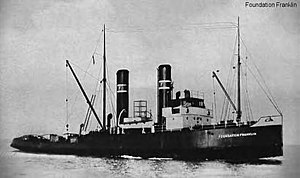Foundation Franklin
The SS Foundation Franklin was a seagoing salvage tug built for the Royal Navy in 1918 but most famous for many daring salvage operations and rescues while operated by Foundation Maritime between 1930-1949. Her many rescues and salvage triumphs were celebrated in Farley Mowat's book The Grey Seas Under.
Foundation Franklin was built as HMS Frisky, a Racia type tug, by John Lewis and Sons Shipbuilding at Aberdeen, Scotland, in 1918. She was designed to move capital warships, and operate in rough weather. The ship was commissioned in the spring of 1919, but the ending of World War I ended the need for the HMS Frisky. She was used to tow warships to Scapa Flow until being laid up. In 1924, the ship was sold and performed towing work on the Rhine River and in the Baltic Sea. The Frisky was later purchased by a German project intending to tow barges across the Atlantic Ocean to Argentina and renamed SS Gustavo Ipland, but the project fell through. The former HMS Frisky then was laid up until 1930.
The ship was purchased in January, 1930 at Hamburg, Germany by Foundation Maritime representative Captain James Sutherland. Brought to Southampton for further refit and inspection, she was registered under the Red Ensign and given the name Foundation Franklin. Brought to Foundation Maritime headquarters in Montreal, Quebec, Canada in 1931, the tug was further refitted by Halifax Shipyards for Atlantic salvage service.
After a few salvage jobs based along the Saint Lawrence River, Foundation Franklin established a homeport at Halifax, Nova Scotia for the rest of her career. One of the most successful and hard-working vessels of her type, Foundation Franklin carried out many remarkable rescue and salvage exploits. She continued to operate in the salvage role until 1948, when, during the tow of the vessel Arosa a hurricane damaged the ship beyond economical repair.
...
Wikipedia

